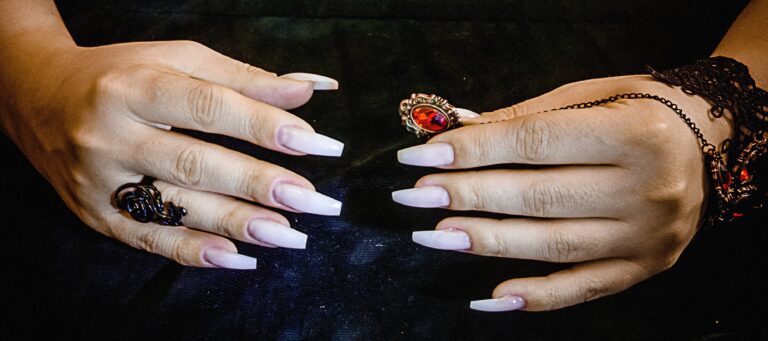“Blue or Not Blue: When Nails Turn Blue Explored”
Blue nails, also known as cyanotic nails, can be a cause for concern and may indicate underlying health issues. Understanding the science behind blue nails, common causes, diagnosing methods, treatment options, and preventive measures is crucial in addressing this condition. In this article, we will explore the various aspects of blue nails and provide key takeaways for better understanding.
Key Takeaways
- Blue nails can be a sign of reduced oxygen levels in the blood, known as cyanosis.
- Circulatory disorders, respiratory conditions, and cold temperatures can contribute to the development of blue nails.
- Clinical assessment, laboratory tests, and imaging techniques are used to diagnose the underlying issues of blue nails.
- Medical interventions, lifestyle changes, and timely emergency care are essential in the treatment of blue nails.
- Preventive measures such as protecting nails from environmental factors, maintaining proper nutrition, and regular monitoring are crucial for nail health.
Understanding Cyanosis: The Science Behind Blue Nails

Defining Cyanosis: A Medical Overview
Cyanosis is a term that refers to the bluish or purplish discoloration of the skin and mucous membranes, including the nails, due to deficient oxygenation of the blood. This condition can be a sign of underlying health issues that prevent the blood from carrying enough oxygen to the body’s tissues.
The presence of cyanosis is often more noticeable in areas with thinner skin, such as the lips, gums, and nails. When it comes to the nails, cyanosis can be observed as a blue tint beneath the nail bed. It’s important to distinguish between temporary changes in nail color that may occur due to cold temperatures or other benign causes, and persistent cyanosis that could indicate a more serious condition.
Early detection and understanding of cyanosis are crucial for effective management and treatment. Here are some key points to consider:
- The severity of cyanosis can vary from mild to severe.
- It may be present at birth or develop later in life.
- Cyanosis can be a sign of various medical conditions affecting the heart, lungs, or blood.
Tip: If you notice a persistent blue color in your nails, it’s important to consult a healthcare professional for a proper assessment.
The Role of Oxygen Saturation in Nail Coloration
The color of our nails can be a subtle indicator of our body’s oxygen saturation levels. When the body is well-oxygenated, nails typically exhibit a healthy pink hue due to the presence of oxygen-rich hemoglobin in the blood. However, when oxygen levels drop, nails may take on a bluish tint, a condition known as cyanosis.
Oxygen saturation refers to the percentage of hemoglobin molecules in the bloodstream that are fully loaded with oxygen. Normal levels range from 95% to 100%. Factors such as bright lights, nail polish, and varying skin tones can affect the accuracy of readings when using devices like pulse oximeters to measure this saturation.
It is important to note that while cyanosis can be a sign of underlying health issues, not all cases are cause for alarm. For instance, temporary blue nails might occur due to cold temperatures affecting peripheral circulation, without indicating a serious problem.
Tip: If you notice a persistent change in nail coloration, it’s advisable to seek medical advice to rule out any potential health concerns.
Physiological vs. Pathological Cyanosis
Cyanosis can be a transient and harmless condition or a sign of a more serious underlying problem. Physiological cyanosis occurs due to benign causes such as exposure to cold temperatures or a temporary reduction in blood flow. It is generally short-lived and resolves on its own once the triggering factor is removed. On the other hand, pathological cyanosis is indicative of a medical condition that impairs the body’s ability to oxygenate the blood effectively.
To differentiate between the two, it is essential to consider the context and duration of the symptoms. Physiological cyanosis should dissipate with warming or cessation of the activity that caused it. Pathological cyanosis, however, persists and is often accompanied by other symptoms such as shortness of breath or fatigue.
Tip: If cyanosis is present without an obvious cause and does not resolve quickly, it is advisable to seek medical attention to rule out pathological causes.
Understanding the distinction between physiological and pathological cyanosis is crucial for appropriate management. While the former may require no intervention, the latter necessitates a thorough investigation to identify and treat the underlying condition.
Common Causes of Blue Nails

Circulatory Disorders and Their Impact on Nail Health
Circulatory disorders can significantly affect the coloration and health of nails, often leading to a condition known as cyanosis, where nails exhibit a blue or purplish hue. This discoloration is a result of inadequate oxygenation of the blood reaching the extremities, including the nails.
Peripheral arterial disease (PAD), venous insufficiency, and Raynaud’s phenomenon are common circulatory issues that can cause blue nails. Each condition disrupts normal blood flow, which can be evident in nail color changes:
- PAD is characterized by narrowed arteries reducing blood flow to the limbs.
- Venous insufficiency occurs when veins struggle to send blood back to the heart.
- Raynaud’s phenomenon causes blood vessels to narrow temporarily, often in response to cold or stress.
Tip: If you notice a persistent blue color in your nails, it’s important to consult a healthcare provider to rule out serious circulatory problems.
Lifestyle factors such as smoking and a sedentary lifestyle can exacerbate these conditions, leading to more pronounced symptoms. It’s crucial to address these factors alongside any medical treatments to improve overall nail and circulatory health.
Respiratory Conditions Leading to Cyanotic Nails
Respiratory conditions can significantly affect the coloration of nails, leading to a blue or purplish hue known as cyanosis. This discoloration is often a result of hypoxemia, a state where the blood contains lower levels of oxygen than normal. When the lungs are unable to effectively oxygenate the blood, due to conditions like chronic obstructive pulmonary disorder (COPD), asthma, or pneumonia, the reduced oxygen levels can manifest visibly in the extremities, including the nails.
Tip: If you notice a sudden change in nail color, especially if accompanied by breathing difficulties, it is crucial to seek medical attention promptly.
The following list includes common respiratory conditions that may lead to cyanotic nails:
- Chronic obstructive pulmonary disorder (COPD)
- Asthma
- Pneumonia
- Pulmonary embolism
- Obstructive sleep apnea
Each of these conditions can impair the lungs’ ability to supply oxygen to the bloodstream, necessitating a thorough clinical evaluation to identify and address the underlying issue.
The Influence of Cold Temperatures on Peripheral Circulation
Exposure to cold temperatures can lead to a temporary condition known as pernio, or chilblains, where the skin, including the nails, may turn blue due to reduced blood flow. This is a natural response as the body constricts blood vessels in an attempt to preserve core temperature. However, prolonged exposure can cause more than just a color change; it can also lead to tissue damage if not addressed promptly.
When the body is exposed to cold, the peripheral circulation is the first to be affected. The vasoconstriction that occurs is the body’s way of reducing heat loss but can also result in decreased oxygen supply to the extremities, including the nails. This can manifest as blue nails, a sign that should not be ignored, especially if persistent or accompanied by other symptoms.
Tip: To prevent blue nails caused by cold temperatures, it is crucial to keep your hands and feet warm and dry during cold weather. If you notice persistent blueness in your nails, consider consulting a healthcare provider to rule out any underlying conditions.
Diagnosing the Underlying Issues of Blue Nails

Clinical Assessment for Cyanotic Nails
The clinical assessment of cyanotic nails begins with a careful examination of the nail beds and surrounding skin. A healthcare provider will look for signs of bluish discoloration, which may indicate inadequate oxygenation of the blood. This physical inspection is often followed by a review of the patient’s medical history, including any existing cardiovascular or respiratory conditions that could contribute to the symptoms.
In addition to visual inspection, capillary refill time is a simple test that can be performed. The provider presses on the nail bed and observes how quickly the color returns to normal after releasing the pressure. A delayed capillary refill time suggests poor peripheral circulation, which could be a sign of underlying health issues.
Tip: Always mention any recent changes in nail color during a medical consultation, as this can aid in a more accurate diagnosis.
The assessment may also include checking for other symptoms that often accompany cyanosis, such as shortness of breath or chest pain. If these symptoms are present, further diagnostic tests may be warranted to investigate the cause of the blue nails.
Laboratory Tests to Determine Oxygen Levels
After collecting data from testing and expert consultations, I meticulously analyze the information to determine the top-performing products. I take into account factors such as pricing, availability, and customer service to make my recommendations. Each product undergoes a comprehensive review where I highlight its strengths and weaknesses. My reviews go through multiple rounds of editing to ensure they are clear, accurate, and easily understandable. It’s important to note that our involvement in these affiliate programs does not compromise the integrity of our reviews or the authenticity of our recommendations. We maintain a commitment to providing honest, unbiased, and valuable insights into the products.
Imaging Techniques in the Evaluation of Cyanosis
Imaging techniques play a crucial role in the evaluation of cyanosis, providing valuable insights into the underlying physiological conditions. Pulse oximetry is a widely used method for assessing oxygen saturation, offering real-time data on the patient’s respiratory status. Additionally, computed tomography (CT) scans and echocardiography enable detailed visualization of anatomical structures, aiding in the identification of potential abnormalities. These imaging studies contribute to a comprehensive diagnostic approach, guiding healthcare professionals in formulating effective treatment plans and interventions. It’s essential to leverage these advanced imaging tools to gain a comprehensive understanding of cyanotic nail conditions.
Treatment Options for Blue Nails

Medical Interventions for Underlying Conditions
When addressing the issue of blue nails due to underlying health conditions, medical interventions are tailored to target the root cause of cyanosis. For circulatory or respiratory disorders, treatment may involve medications to improve blood flow or oxygen uptake. In cases where chronic diseases such as diabetes or heart disease are involved, managing these conditions effectively is crucial to alleviating symptoms, including nail discoloration.
Depending on the diagnosis, a range of medications may be prescribed, including:
- Vasodilators to widen blood vessels and improve circulation
- Anticoagulants to prevent blood clots
- Bronchodilators for patients with asthma or COPD
- Antibiotics if an infection is present
Tip: It’s essential to follow the prescribed treatment regimen closely and report any changes in nail color to your healthcare provider promptly.
Regular follow-up appointments are necessary to monitor the effectiveness of the treatment and make adjustments as needed. It’s also important to maintain open communication with your healthcare provider to manage any side effects that may arise from medication.
Lifestyle Changes to Improve Circulation
Improving circulation can be a key factor in preventing and treating blue nails caused by cyanosis. Simple lifestyle changes can have a significant impact on blood flow, especially to the extremities like the fingers and toes. Regular physical activity is paramount; even low-impact exercises such as walking can enhance circulatory health. Walking daily, as a form of exercise, is known to lower blood pressure and increase blood flow throughout the body.
Diet also plays a crucial role in maintaining good circulation. Incorporating foods known to improve blood flow, such as cayenne pepper, onions, cinnamon, and garlic, can be beneficial. Here is a list of foods that are particularly effective:
- Cayenne pepper
- Onions
- Cinnamon
- Pomegranate
- Turmeric
- Walnuts
- Ginger
- Garlic
Tip: Consistency in both exercise and dietary habits is essential for long-term circulatory health. Making gradual changes and sticking to them can lead to noticeable improvements over time.
Avoiding a sedentary lifestyle is equally important. Regular breaks from sitting, whether it’s standing up or taking short walks, can help maintain circulation. Additionally, refraining from smoking and managing stress levels are vital lifestyle adjustments that contribute to overall vascular health.
When to Seek Emergency Care for Cyanotic Nails
Cyanosis in the nails can indicate a serious underlying condition that requires immediate medical attention. If you observe cyanotic nails accompanied by symptoms such as chest pain, shortness of breath, or dizziness, it is crucial to seek emergency care without delay. These symptoms may signify a severe circulatory or respiratory issue that demands prompt evaluation and treatment. Remember, timely medical intervention is vital in addressing potentially life-threatening conditions associated with cyanotic nails.
Preventive Measures and Nail Care

Protecting Nails from Environmental Factors
Protecting nails from environmental factors is crucial for maintaining their health and strength. Exposure to water, detergents, chemicals, weather fluctuations, and ultraviolet rays can weaken and damage nails over time. It’s important to minimize prolonged exposure to these elements to prevent nail brittleness and discoloration. Additionally, incorporating a balanced diet rich in essential nutrients, such as vitamin E and oils, can aid in repairing and safeguarding nails from external factors. Regular moisturizing and nail strengthening treatments can also contribute to overall nail health and resilience. Remember, healthy nails start with proper protection and care.
Nutritional Considerations for Nail Health
A balanced diet plays a crucial role in maintaining the overall health of your nails. Nutrients such as vitamins and minerals are essential for the prevention of blue nails, which can be indicative of underlying health issues. For instance, vitamins A, C, D, and E, alongside minerals like biotin, iodine, zinc, and selenium, are pivotal in supporting nail strength and color.
Incorporating a variety of foods rich in these vitamins and minerals can help ensure your nails receive the nourishment they need. Here’s a simple guide to some key nutrients and their sources:
- Vitamin A: Carrots, sweet potatoes, and leafy greens
- Vitamin C: Citrus fruits, strawberries, and bell peppers
- Vitamin D: Fortified foods, fish, and exposure to sunlight
- Vitamin E: Nuts, seeds, and spinach
- Biotin (Vitamin B7): Eggs, almonds, and whole grains
- Iodine: Seafood, dairy, and iodized salt
- Zinc: Meat, shellfish, and legumes
- Selenium: Brazil nuts, seafood, and grains
Tip: A well-rounded diet not only supports nail health but also boosts your overall well-being. If you suspect your diet lacks certain nutrients, consider consulting a healthcare provider for advice on supplementation.
It’s important to note that excessive intake of certain vitamins, particularly fat-soluble ones, can lead to toxicity. Therefore, it’s essential to maintain a balanced diet and seek professional guidance when considering supplements. Regular monitoring of nail health can serve as an early indicator of potential deficiencies or other health concerns.
Regular Monitoring for At-Risk Individuals
For individuals at risk of developing cyanotic nails, regular monitoring is a crucial step in early detection and management of potential underlying conditions. Establishing a routine for nail inspection can help in identifying changes that may warrant further medical evaluation.
- Self-examination: Individuals should be encouraged to perform regular self-examinations of their nails, looking for any signs of discoloration or other abnormalities.
- Professional assessments: Regular visits to healthcare providers for nail assessments can provide a more thorough evaluation and help in tracking any progression of symptoms.
- Frequency of checks: The frequency of these checks should be based on individual risk factors and medical history.
Tip: Keeping a journal of nail changes can be beneficial in providing healthcare professionals with a detailed history, which can aid in diagnosis and treatment planning.
Taking care of your nails is essential for maintaining their health and beauty. By following preventive measures and practicing good nail care, you can ensure that your nails stay strong and beautiful. At NAILinspire.com, we provide the ultimate online nail art design library, offering a wide range of inspiration and tips for creating stunning nail designs. Visit our website today to explore our collection and unleash your creativity!
Frequently Asked Questions
What causes nails to turn blue?
Blue nails can be caused by a variety of factors, including circulatory disorders, respiratory conditions, and exposure to cold temperatures.
Is blue nail discoloration a sign of a serious health issue?
In some cases, blue nails can indicate an underlying health problem that requires medical attention. It’s important to consult a healthcare professional for proper evaluation and diagnosis.
Can blue nails be a result of poor circulation?
Yes, blue nails can be a sign of poor circulation, especially when combined with other symptoms such as cold hands and feet.
Are there any lifestyle changes that can help prevent blue nails?
Maintaining a healthy lifestyle, including regular exercise and avoiding exposure to extreme cold, can help improve circulation and reduce the risk of blue nails.
When should I seek emergency care for blue nails?
If you experience sudden and severe blue discoloration of the nails, along with symptoms such as shortness of breath or chest pain, seek emergency medical care immediately.
What role does oxygen saturation play in nail coloration?
Oxygen saturation levels in the blood can impact the color of the nails, with lower oxygen levels potentially leading to cyanosis and blue discoloration.






